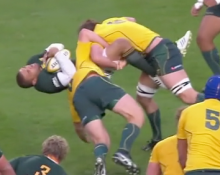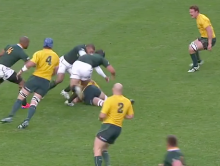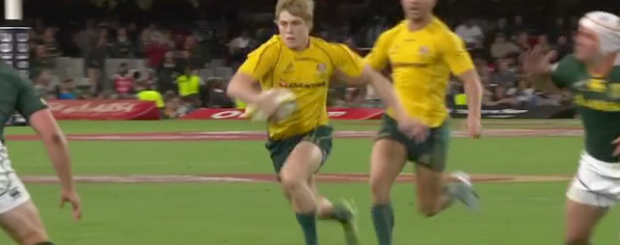Scheduled Website Maintenance
We’re currently in the process of moving to a new and improved server environment. During this transition, the website may experience brief interruptions or temporary outages.
We appreciate your patience while we complete this upgrade. Service will return to normal shortly, with improved performance and reliability.
Thank you for your understanding.
The Wallabies were handed a tough assignment in Durban last night for their third Tri Nations match against the real Springboks team — one strengthened by 13 changes to the run-on side. With no sleep at all and a 3:30am departure from their Auckland hotel last Sunday, they endured a 26-hour journey, lost luggage (this is becoming the norm for RSA) and the normal jet-lag problem. That they were to run out convincing winners — albeit by a close points margin of only 14–9 — speaks volumes for the team’s courage and commitment.
The reconstituted Springboks team were undoubtedly rusty and they will develop over the coming weeks, but they surely had much the better of the preparations, being at home and well-rested. Yet the Wallabies played pretty much all the rugby and with more clinical finishing could easily have won by about twenty points.

After last weekend I stressed the need for enthusiasm and urgency right from the first minute of the game and that is what we got from the Wallabies. The urgency and power in their early tackles gave us that clear sign and dominant tackles – a most desirable statistic in team KPIs – were thick on the ground. They had clearly made the decision to get a leg – unfortunately, sometimes both legs – off the ground in order to drive the big Springboks back. This direct, aggressive confrontation worked a treat, as did similar qualities with their ball-in-hand attack.
Quade Cooper and others were much straighter and, as always, opportunities for excellent footwork and sleight-of-hand presented themselves and, being the instinctive, quality rugby players that they undoubtedly are, they snapped them up. Numerous try-scoring chances were then created but, for a couple of reasons, most of them came to nothing. This is an excellent step forward, however, and so long as they recognise the vital importance of these fundamentals, the tries will soon flow.
A famous old Wallaby centre, Cyril Towers – an important mentor for me – used to say often that ‘a rugby player’s hands must move independently of his body’. Explained further, this means that a rugby player must not, generally, use his arms to generate power in his run – although this is the normal, driving running action. The arms must remain loose, with the hands ready for even an unexpected pass. With a bit of work on this – the improvement is always in the detail of the fundamentals – Horwill, for example, would have easily taken the pass from Genia in that first-half blindside snipe. And so would a few other opportunities have continued, perhaps to the conclusion of a score!
In our desire for more clinical execution, we need, most importantly, a huge improvement in the accuracy of our support play and our urgency at the tackle contest. There was some improvement this week in the latter area, but we still have a long way to go. I spoke last week of the need for ‘no hesitation’ and ‘no daylight’ at these contests, but we often see a deliberate hesitation, actually waiting for the ball-carrier and tackler to go to ground, in order for the support player to get an opponent in his sightsfor the clean-out. Ben Alexander is a particular offender in this regard – he has plenty of mates, though!
I have been on about the lack of quality in our support play for some seasons now and, certainly in all of this season’s Tests, I have been consistent after every match. In broad terms, the line and depth that our support players strive to achieve is too flat and too wide. This limits the options available for the ball-carrier to enable him to manoeuvre defences, in the way that James O’Connor did for McCabe’s try.
This was quite simple for O’Connor, given the mismatch of attack over defence, but even the most able defenders can be forced on to unwanted lines by a quality attacker – if he has the freedom to do so! In addition – and this was a stand-out error in technique in this match – our support runners frequently allow defenders to get between them and the ball-carrier. Other sports can show us the way, and in my time as Wallabies coach, I often used netball as the example for us. This poor support play gives no opportunity for continuity, save the risky pass through, or over, defenders.

There were numerous examples. One glaring one came after an early, promising break by Rocky Elsom. Horwill, Moore and Higginbotham were too wide and too flat, and each allowed defenders to block them from the pass. I demand that Rocky has ‘the right to expect a support player in behind him, tracking his line of run, with sufficient depth to prevent an over-run’. At worst he could have turned in the fullback’s tackle and play would have continued.
Way back in 1986, I got a good lesson in support play from the All Blacks in a Bledisloe Cup match – they are masters in support play! A mid-field break by them was chased by their two flankers. One raced up flat and wide to take the scoring pass and was covered immediately by the defence. The other hung back and tracked the runner, with depth, and the ball-carrier turned in the tackle and off-loaded for the try. If I recognise the lesson as valid and important, I never forget it!
The Springboks were, as I have said, rusty, but we would be foolish to discount them. Their second-half substitutions severely restricted their performance. They have a difficult pool for the World Cup, with matches against Wales, Samoa and Fiji (who gave them an almighty scare in 2007), but this could be the very preparation they need to bring out their best. Quality players do not evaporate overnight!
For the Wallabies, the entire team played better. Genia got around the corner frequently and this made space for Elsom, Sharpe, Horwill and Moore. Better support play will bring more dividends from this. Cooper was much straighter and infinitely better – long may this continue! Our bench, even though we used only two, made significant contributions. Indeed I would not be surprised to see both Radike Samo and Anthony Faingaa selected in the starting lineup for our next match. Both were aggressive, urgent, powerful and, most importantly, effective!
I have trouble agreeing with whoever selects the man-of-the-match. Last week I was for Moore; ‘they’ went with Horwill. This week, I thought that Horwill was one of a few worthies; ‘they’ went for Moore. Not a big deal; they all had a go and right from the start!
For the record, the ref struggled! Amongst plenty of questions that could be asked of him, can someone please explain his decision to prematurely blow up play, right on South Africa’s try-line, and signal half-time?


